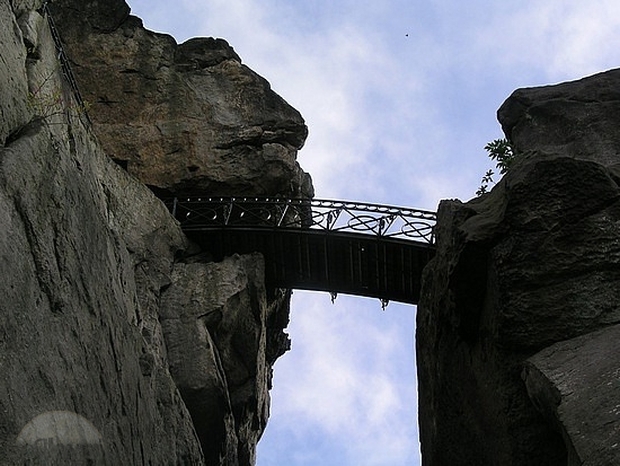A clump of jagged rocks, grotesquely carved by water and wind, in a north German hill forest is the site of many ancient rituals. Rich in spiritual associations, this remote sanctuary was once the focus of a bitter struggle between pagan worshippers and Christian monks. Visitors to the forested uplands of Teutoburger Wald, North Rhine-Westphalia, might well stop suddenly in their tracks to gaze open-mouthed in wonder at the first arresting sight of the Externsteine.
Towering 130ft (40m) above the forest floor, and etched dramatically against the sky, is the curious vision of five gnarled sandstone pillars riddled with caves, passages, and secret chambers. The fairytale setting of the rocks – evoking a picture in a child’s story book – only adds to the air of enchantment. Located in an area thick with sacred ancient sites, this is a place with powerful mystical and mythological associations: according to folk tradition, these stones were raised overnight by giants and burned by the devil. The flames of the inferno were believed to be responsible for their grotesquely contorted appearance.
This remarkable natural feature holds a place in German spiritual tradition similar to that of Stonehenge in Britain. Firm evidence about the origins and significance of the Externsteine has proved tantalizingly elusive: one theory holds that it was used as a major ceremonial centre of worship in the Stone Age; another that its religious origins date no farther back than the 12th century, and that the site is a re-creation of the holy places of Jerusalem, inspired by Crusader’ tales.
When Christianity supplanted paganism in Germany around 722, old sites of worship were appropriated by the new religion. In medieval times the Externsteine was used as a refuge by Christian hermits. A legacy from this period is a magnificent bas-relief carving on one of the larger rocks. The Descent from the Cross was carved around 1120 by Cistercian monks from the abbey at nearby Paderborn, who used the Extersteine’s rock-cut chambers for prayer.
A notable detail of the carving is the Irminsul, or world-pillar – believed by pagan Saxons to support the universe. Symbolizing Christianity’s dominance over paganism, the Irminsul is bent double to form a foot-support on which Nicodemus (who in the biblical account helped to bury Jesus) stands to remove Christ’s body from the Cross. Significantly, the feet of Nicodemus have been deliberately chipped away – a mutilation explained by locals as the pagan’ revenge for the Cistercans’ symbolic humiliation of their sacred emblem.

The crags of the Externsteine are riddled with man-made caves and passages which have been enlarged by successive generations. While some bad uses which are obvious, such as the chapel, the purpose of many others remains a mystery – there are steps that lead nowhere, odd platforms and niches, a rock-cut coffin, small drilled holes and larger apertures cut into the rock faces.
The widest rock pillar contains a large, irregularly shaped chamber, accessible through two doorways. The north-eastern entrance and both the chamber’s windows face the mid-summer sunrise, making it quite likely that secret pagan ceremonies took place here. The second doorway gives entry via a narrow, bizarrely shaped carved passage. Many of the chamber’s features are similar to those found in subterranean religious structures elsewhere in Europe.

A small, delicate chapel, the most evocative place in the Externsteine, has been hewn from the rock near the top of one of the pillars. Accessible only by rock-cut steps and a precarious footbridge, the chapel is roofless and, at its eastern end, there is a round-headed niche containing a pillar-altar unlike anything found in conventional church architecture. Directly above the altar is a circular window 20m (50cm) wide.
Antiquarian researchers in the 19th century observed that it was aligned toward both the mid-summer sunrise and the most northerly rising point of the moon – two important astronomical occurrences marked by ceremonies at many prehistoric stone circles and similar sites. The researchers maintained that the chapel had been built high above the ground to permit a clear view of the sun and moon as they rose behind specific landmarks on the horizon beyond the forest canopy. Moreover, they found that the Externsteine lies at more or less the same latitude as Stonehenge, so the direction of the mid-summer sunrise – an important factor to Europe’s astronomer priests – is identical in both places.

Wilhelm Teudt, an evangelical parson, expanded on this research in the 1920s. the found that the site of the Externsteine lies on the network of ‘holy lines’ that he had discovered in northern Germany. He claimed that these lines, roughly equivalent to the ley lines identified by other researchers, linked the Extersteine with ancient sites elsewhere, including the stone circle at nearby Bad Meinberg.
Above the chapel, Teudt belied, there had once been other chambers and wooden structures used to observe the sun, moon and stars, suggesting that the Externsteine was a centre of an ancient solar cult. His discoveries also convinced him that the roofless and ruined condition of the observatory-chapel was the result of deliberate vandalism by Cistercian monks. He showed that a 50-ton slab lying at the foot of the rock pillar had been broken away from the chapel’s side. The monks had destroyed the sanctuary to purge the site of its pagan associations, thereby rendering it fit for Christian worship.
-end-




































